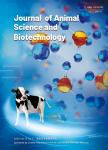Conceptus elongation in ruminants: roles of progesterone, prostaglandin, interferon tau and cortisol
Conceptus elongation in ruminants: roles of progesterone, prostaglandin, interferon tau and cortisol作者机构:Department of Animal Science and Center for Reproductive BiologyWashington State University
出 版 物:《Journal of Animal Science and Biotechnology》 (畜牧与生物技术杂志(英文版))
年 卷 期:2015年第6卷第2期
页 面:151-162页
核心收录:
学科分类:090603[农学-临床兽医学] 0710[理学-生物学] 0831[工学-生物医学工程(可授工学、理学、医学学位)] 0832[工学-食品科学与工程(可授工学、农学学位)] 1004[医学-公共卫生与预防医学(可授医学、理学学位)] 0905[农学-畜牧学] 09[农学] 0906[农学-兽医学] 0703[理学-化学] 0836[工学-生物工程]
基 金:supported in part by AFRI competitive grants 2009 – 01722 and 2012-67015-30173 from the USDA National Institute of Food and Agriculture
主 题:Conceptus Cortisol Endometrium Interferon Prostaqlandin Ruminant
摘 要:The majority of pregnancy loss in ruminants occurs during the first three weeks after conception, particularly during the period of conceptus elongation that occurs prior to pregnancy recognition and implantation. This review integrates established and new information on the biological role of ovarian progesterone (P4), prostaglandins (PGs), interferon tau (IFNT) and cortisol in endometrial function and conceptus elongation. Progesterone is secreted by the ovarian corpus luteum (CL) and is the unequivocal hormone of pregnancy. Prostaglandins (PGs) and cortisol are produced by both the epithelial cells of the endometrium and the trophectoderm of the elongating conceptus. In contrast, IFNT is produced solely by the conceptus trophectoderm and is the maternal recognition of pregnancy signa that inhibits production of luteolytic pulses of PGF2α by the endometrium to maintain the CL and thus production of P4. Available results in sheep support the idea that the individual, interactive, and coordinated actions of P4, PGs, IFNT and cortisol regulate conceptus elongation and implantation by controlling expression of genes in the endometrium and/or trophectoderm. An increased knowledge of conceptus-endometrial interactions during early pregnancy in ruminants is necessary to understand and elucidate the causes of infertility and recurrent early pregnancy loss and provide new strategies to improve fertility and thus reproductive efficiency.



